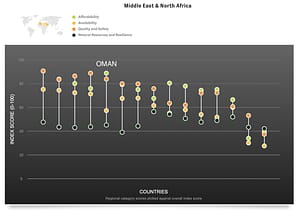Temperatures in Oman often top a sizzling 50 deg C in the summer months. Much of the country is arid desert with only 4.8% of land area in agricultural production and water resources under severe pressure. Both the economy and population are forecast to grow at around 2-3% per year and climate change is expected to make conditions even tougher.
Can 309.5 million square km of mostly desert support a growing population of 5-6 million people?
According to the latest economist food security index of 113 countries, Oman ranks a creditable 40th. However, on the metric of resilience, the ranking is 76th.
Oman compares well against North African and Middle Eastern nations for food quality and affordability. If you click on the dots in the image below you can see that with regards to natural resources and resilience, the oil rich Middle Eastern countries on the left are in worse shape than countries in more moderate climatic conditions such as Turkey and Egypt. So far, oil wealth has not overcome the unfair disadvantages associated with building nations in deserts.

Israel Qatar Kuwait UAE Barain Saudi Arabia Turkey Jordan Algeria Tunisia Morocco Egypt Syria Yemen
At first glance, it seems difficult to see much hope in this situation. More likely that Oman is doomed to be in the vanguard of countries overwhelmed by climate catastrophe.
BUT – what if it does not have to be that way? As innovators, we appreciate that when downsides are turned into upsides, radical, significant innovation occurs. What if, although Oman has many unfair disadvantages, those same factors can, somehow be the unfair advantage?
In a project last year, we explored how Oman could build its food and beverage sector. We’ve already shared some thoughts from that work on how Oman could reverse desertification by adopting regenerative agriculture practices, ‘leapfrogging’ the approaches of intensive monoculture production adopted in the west. During the research, we heard, as we expected, plenty about the challenges of growing food in the desert. But we were excited to hear a much more positive message too.
Geoff Lawton’s take on the matter
Australian permaculture expert Geoff Lawton emphasises that the potential of desert agriculture is all too often overlooked. A key advantage is the diversity of crops that can be grown. “Agricultural companies push just four crops – soy beans, wheat, rice, and potatoes – and the whole agricultural system is set up around those,” says Lawton. Diversifying from those four means more than simply catering to the whims of consumer tastes: there’s a huge benefit for food security.
Lawton elaborates on the concept of ‘climate analogue’ species, which is how this agricultural diversification could be achieved. “Tell me the latitude, the altitude, and the distance from the ocean, and that starts the search for climate analogues. You can look all over the world. There’s a Noah’s ark of desert species that could be grown in the deserts of Oman” he says.
Nutrition – more than just the calories
Lawton is also quick to point out the nutritional benefits. “If you get it right, some of the healthiest food with the highest nutrient density in the world, can be grown in the desert”, he says.
When we eat common crops such as sugarcane, corn, and sorghum, they are digested into simple sugars that can aggravate obesity and adult-onset diabetes. In contrast, a team from the University of Arizona reported last year that eating desert plants can reduce blood sugar levels and boost the diversity of antioxidants in the body. And some desert plants benefit our gut health by improving food digestion and enhancing the gut microbiome.
And those benefits add up to economic potential, something recognised over a decade ago by the UN Environment Program. The UN report, the Global Deserts Outlook, highlighted opportunities in deserts to grow crops for both agricultural and medicinal purposes, to nurture shrimp and fish farms, and as sites for large-scale solar or wind power generation.
The concept of agrivoltaics brings those benefits together by using solar panels to provide shade land for growing crops or even for grazing animals, something explored by the Fraunhofer Institute for Solar Energy. Although the approach means slightly fewer solar panels compared with a tightly packed arrangement, overall the land becomes far more economically productive.
As Canadian philosopher Matshona Dhliwayo said: “A rose in a desert can only survive on its strength, not its beauty.” The challenge is to harness that strength to yield an ‘unfair advantage’ for Oman – and for other arid regions across the planet.
Oman’s Unfair Advantage?
Together with Morocco, Oman is famous for the ancient Aflaj irrigation and agricultural system. Several surviving examples are Unesco world heritage protected sites of outstanding universal value. These sites and traditional desert agricutural systems have many principles in common with Permaculture.
The Future
“The farther back you can look, the farther forwards you are likely to see”
Just add water
“Honour the wisdom of the past and bring it technologically forward without losing the sustainability order”

